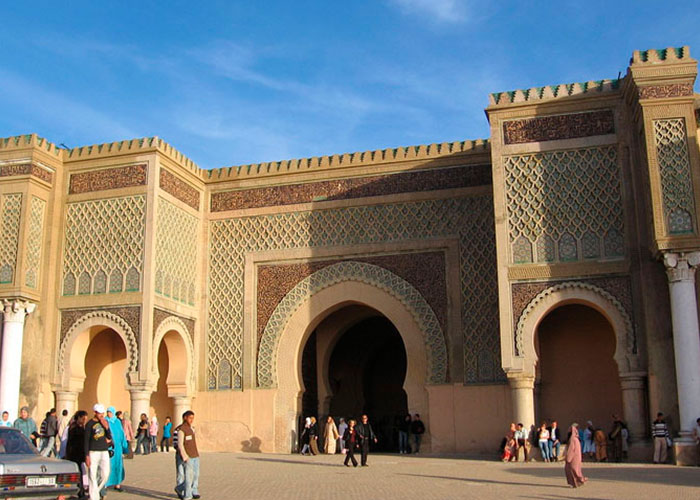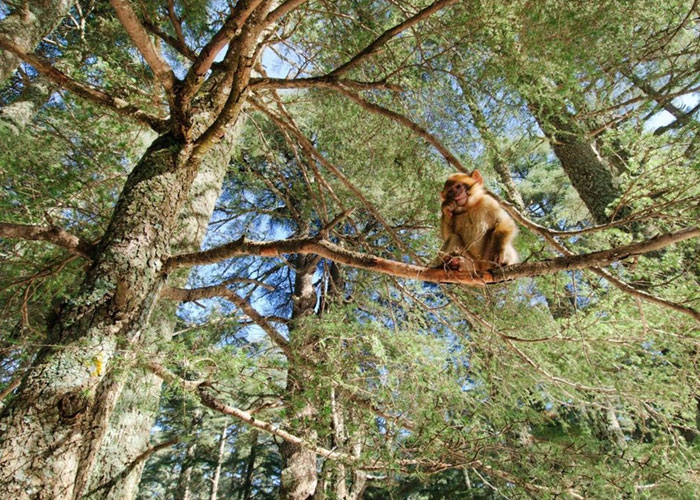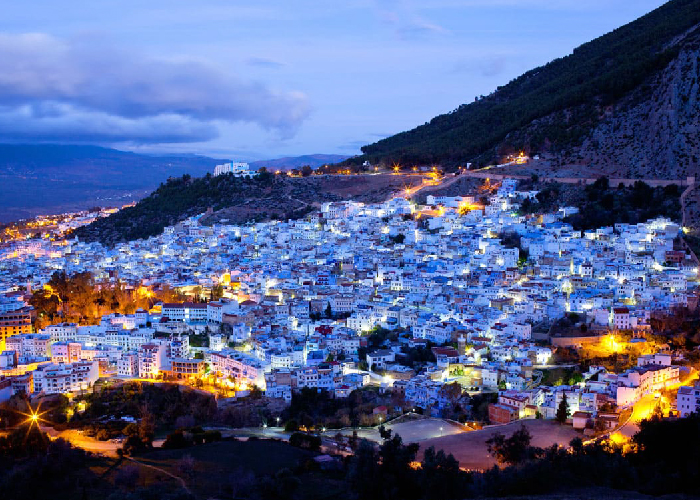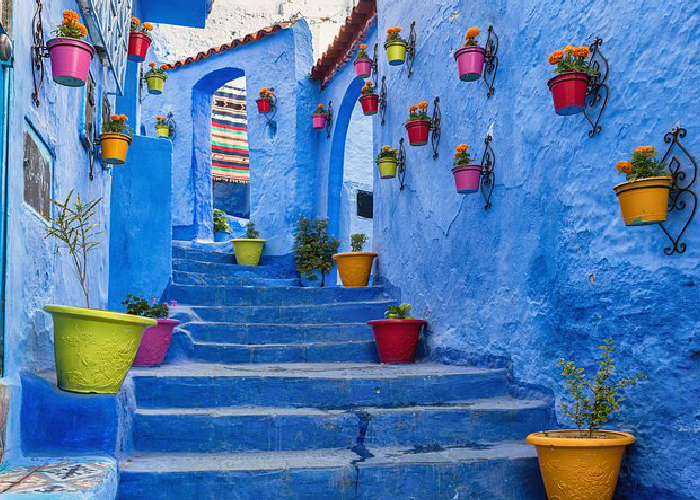11 Days Tangier to Fes via the Sahara desert
Day 1: Tangier – Chefchaouen
Reception in Tangier and transfer to Chaouen for overnight stay at the hotel.
DAY 2: Chaouen
After breakfast, visit the ancient capital of Chefchaouen. Located at the foot of the Rif Mountains’ Tiska (2050m) and Megu (1616m), it rises like two horns, hence the name of the town, which means ‘horn kind’ in Berber.
You will enjoy the Medina of Chaouen (old part of town), and as you pass through the five medina gates and cross the winding streets lined with bright blue and white houses, the smell of freshly baked bread and ready-made tagines wafting from the wood-burning stoves contrasts with the colorful variety of goods in the shops and bazaars, making this walk a feast for the senses. The walk will be a feast for the senses. After the walk, you will be invited to have tea in Utah El Hammam Square, the busiest square in the medina of Chaouen. The octagonal minaret of the Citadel and Grand Mosque towers over it. We will stay at the hotel and continue our sightseeing into the evening.
DAY 3: Chaweng – Volubilis – Meknes
After breakfast at the hotel, drive 200 km to Meknes. On the way, stop for a rest in the silence and beauty of the Mamora Forest. We will spend some time relaxing in this magnificent forest, which is said to be the largest cork oak forest in the world and is a Biosphere Reserve.
After a break, we continue our journey to the Roman city of Volubilis, 27 km north of Meknes. It is the most important archaeological site in Morocco and a UNESCO World Heritage Site.
Continue to Meknes, one of Morocco’s four royal capitals alongside Fez, Marrakech and Rabat. In Meknes, visit the Bab al-Mansour Gate, one of the largest and most beautiful gates in Morocco, built in 1732. The Bad al-Mansour Gate is the regular entrance to the medina, where you can admire the bazaar, historical buildings and the Great Mosque, built in the 12th century by the Almoravids. Accommodation.
DAY 4: Meknes – Imilchil
After breakfast, depart Meknes for Imilchil, a village in the central High Atlas, in the Asif Merur (White River) valley at an altitude of over 2,200m. The region is rich in pastureland. We visit Lake Tislit, the famous bride’s lake, which, together with Lake Isli, the groom’s lake, has created a beautiful love legend.
What makes the site worth a visit is the history of the lake: legend has it that two young lovers were unable to marry due to family objections and took their flocks separately to the mountains. When they did so, many tears flowed from their eyes and two lakes, Lake Tisli and Lake Isli, were created near Imilchil. Dinner and overnight stay in a traditional mountain hotel.
DAY5: Imilchil – Todra Gorge – Alnif
From Imilchil, follow the route to the Todra Gorge. The route crosses picturesque gorges surrounded by mountains and the vast plateau of the Asif Merl Valley, a cattle and pastoral area. Away from the tourist routes, in the heart of the Atlas Mountains, you can travel back in time. Here you will find the oldest Berber settlement in the country, with earth and stone houses scattered throughout the valley. They are semi-nomadic and keep the traditions of their ancestors alive.
Arrive at the village of Tamtatusht and from there descend through the Todra Gorge, passing through the spectacular Tizi n Telramt Pass at an altitude of 2650 m to the palm groves of Tinerghir, one of the natural gateways between the Atlas and the Sahara, and one of the most beautiful oases in the region. The Todra Gorge lies in the northern part of the Tinghir palm forest in the foothills of the eastern High Atlas. This palm forest gradually narrows and the limestone cliffs surrounding it reach a height of 300 meters, with the narrowest part being 10 meters wide and separated by 20 meters. From here, continue to Alnif, the town of Anti-Atlas, at the foot of the basalt mountains of Jubel Sagro, the birthplace of the Berbers, also known as the Desert Mountains. Dinner and overnight stay in a hotel.
DAY6: Merzouga – Rissani – Merzouga
After breakfast, drive to Rissani, 35 km from Merzouga. Visit the market, which was an important trading center for the desert people. Rissani market is a traditional marketplace for woodworkers, livestock and spice traders. …… Here, visitors can see a curious donkey park where market traders keep donkeys. Rissani is the origin of the Alaouite kingdom called Sijilmasa and was said to have been an important presence in the region.
In the afternoon, return to Merzouga on desert roads. Merzouga, the ‘Gateway to the Dunes’, is a town in south-eastern Morocco at the foot of the Great Erg Chebbi Desert (Sahara Desert), 22 km long (north-south), 5 km wide and up to 150 m high. You can place your 4×4 at the foot of the dunes, board a camel and watch unforgettable sunsets on the high desert dunes (if you reach earlier). Spend the night in a luxury camp in the heart of the desert.
Climbing the dunes, watching the sunset and sunrise is sure to be an enjoyable experience.
Day 7: Desert to desert
You wake up early to watch the sunrise over the dunes. After a delicious breakfast, we drive to Ramlia, a beautiful palm-trees oasis in the Tafilalet region of the south-eastern Sahara, close to the Algerian-Moroccan border.
Ramlia is remote and its inhabitants are ancient nomads, consisting of black people also Ait Atta, a large group of Amazighi people from the Sahara desert of south-eastern Morocco, and are known for their excellent hospitality.
After dinner, overnight in a hotel in the village of Merzouga.
DAY8: Merzouga – Ziz Valley
Breakfast and spend the day in the stunning Ziz Valley.
The Ziz Valley is a spectacular sight, with limestone valleys lined with date palms and dotted with mud-brick houses.
The Ziz River originates in the High Atlas and flows southwards along imposing cliffs, irrigating the huge palm forests of Tafilaret. The water continues through the desert and disappears again after more than 270 km.
Dinner and breakfast at a hotel in the valley.
DAY 9: Ziz Valley – Fez
After breakfast, drive from the Valley to Midelt. A short stop in the famous cedar forests of the Middle Atlas. Then to Ifrane, a Middle Atlas town situated in the mountains at an altitude of 1,713m and known as the ‘Little Switzerland of Africa’ due to its cold climate, and from here to Fez. Overnight in a riad or a hotel.
DAY 10: Fez
Full day of sightseeing in Fez. Rest the evening at your hotel.
The city of Fez is considered the religious and cultural center of Morocco. The city is divided into three zones: the old town of Fes el-Bali, within the city walls; the new town of Fes Jdid, with the Jewish quarter of Mellah; and the French quarter of Ville Nouvelle in the north-west of the city. The Medina of Fes el-Bali is one of the largest medieval architectural complexes in the world. The entire medina is a UNESCO World Heritage Site, and its bazaars and alleys have not changed since the Middle Ages. To explore the Medina of Fes el Bari, take a stroll through the Bab Boujloud gate and walk through a maze of narrow alleys, avoiding mules carrying large loads.
- Visit the Bouanani Madrasa, with its precious cedar woodwork, stucco, marble and onyx jewelry.
- Zaouiat Moulay Idriss.
- An Andalusian cityscape with a mosque and Madrasa El Sahrij.
- The Arab-Andalusian style former Dar Bata Palace, dedicated to the art and traditions of Fez.
- The University Mosque of Al-Qarawiyyin, one of the oldest mosques in the world, was founded in 859 by Fatima Alfihri.
In the Middle Ages, the town developed into an important trading post in the Maghreb as a tannery town and was a major producer of adarg (oval leather shields), which were used by the Muslim cavalry of Al-Andalusia under the name ‘addarca’.
‘In the 17th century, the Andalusian Muslims of Fez developed the fez or tarbush as a fashion of high society. The artisans involved in its design were the elite of the city’s bazaars; until the 19th century, when the French and Turks began to develop it, the city of Fez was the sole production center.
DAY 11: Fez – city
Breakfast at hotel, transfer to airport on time, end of service.







